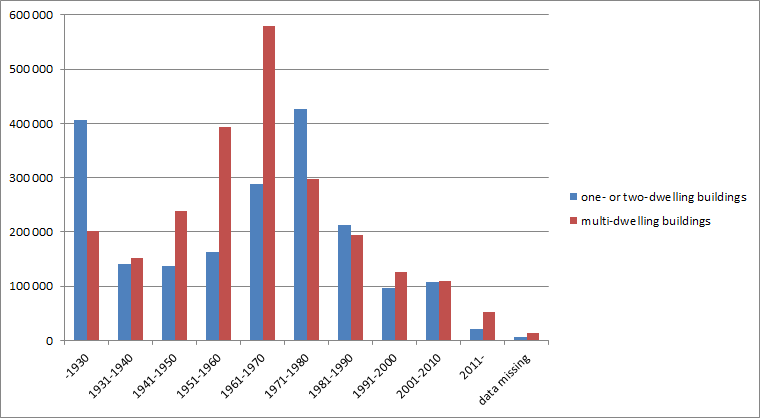Dwelling stock 2014-12-31:
Nearly 4.7 million dwellings in Sweden
Statistical news from Statistics Sweden 2015-04-23 9.30
The number of dwellings on 2014-12-31 was 4 669 081. These are divided into 2 007 664 dwellings (43 percent) in one- or two-dwelling buildings, 2 356 831 (50 percent) in multi-dwelling buildings, 226 731 (5 percent) in special housing and 77 855 (2 percent) in other buildings.
Rental units dominate in 260 of the country’s 290 municipalities
Although tenant-owned dwellings have increased more than rental units in recent years due to new construction and rearrangement, rental units constitute 60 percent of the total dwelling stock in multi-dwelling buildings while 40 percent consists of tenant-owned dwellings. Of the 290 municipalities, rental units dominate in 260. Only 30 municipalities have more tenant-owned dwellings than rental units. Half of these are located in Stockholm County. The largest proportion of tenant-owned dwellings are in Vallentuna (91 percent) followed by Täby (89 percent) and Lomma (85 percent).
Private ownership is the most common form of tenure at 92 percent for one- or two-dwelling buildings. The proportion of rental units and tenant-owned dwellings in one- or two-dwelling buildings are 4 percent each.
Housing cooperatives most common owners of multi-dwelling buildings
Of the dwellings in multi-dwelling buildings, about 947 000 (40 percent) are owned by housing cooperatives, slightly over 684 000 (29 percent) are owned by municipal housing companies and roughly 556 000 (24 percent) by Swedish joint-stock companies and other legal persons.
When it comes to one- or two-dwelling buildings, the vast majority (92 percent) are owned by private persons and only 4 percent by housing cooperatives.
The dwelling’s size and age
The average dwelling in multi-dwelling buildings is 68 square meters while the average one- or two-dwelling building is 122 square meters.
927 000 (46 percent) of the Swedish one- or two-dwelling buildings were built between 1961 and 1990. However, every fifth house (or 20 percent) of one- or two-dwelling buildings was built as early as before 1930. When it comes to multi-dwelling buildings, most of them (54 percent) were built between 1951 and 1980.

Special housing
The number of dwellings in special housing amounts to a total of 226 731 dwellings spread across 126 369 special housing for elderly/disabled, 88 268 housing for students and 12 094 other special housing. An apartment in a retirement home is on average 39 square meters while a student has to make do with 28 square meters in the average student housing. Most of the student housing can be found, not unexpectedly, in the major university cities.
| Municipality | Number of dwellings |
|---|---|
| Uppsala | 11 031 |
| Göteborg | 9 856 |
| Lund | 8 700 |
| Stockholm | 8 294 |
| Umeå | 5 836 |
| Linköping | 4 621 |
| Växjö | 3 565 |
| Örebro | 2 941 |
Definitions and explanations
The statistics are based on the Dwelling Register which is a national register of all Swedish dwellings. The register is managed by the National Land Survey, which also is the responsible agency. Statistics Sweden receives the data from the National Land Survey for producing current household and housing statistics.
One- or two-dwelling building means detached one- or two-dwelling buildings as well as semi-detached, row and linked buildings.
Multi-dwelling building means buildings with three or more apartments, including balcony access housing.
Other building means buildings that are not intended for residential purposes, e.g. buildings used for business or public function.
Special housing means dwellings for elderly/disabled, student housing and other special housing.
The apartment’s type of tenure is based on the ownership and not how the residents possess the apartments.
Statistical Database
More information is available in the Statistical Database
Feel free to use the facts from this statistical news but remember to state Source: Statistics Sweden.
